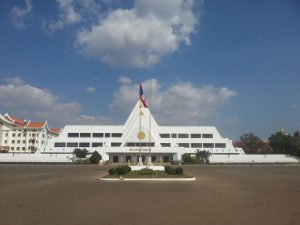This past weekend, Vietnamese state media carried a short article describing the handover of a new parliament building in Laos, funded and built by the Vietnamese government.
The building in question is the Lao National Assembly House, whose imposing five-story neoclassical edifice is intended to replace the squat modernist parliament building in the capital Vientiane. Built at a whopping cost of $111 million, paid in full by the Vietnamese government, the building will serve as a venue for Laos’s rubber-stamp parliament, and will also serve “a cultural research center.”
Described previously by state media as “a gift of the Vietnamese Party, State, and people,” the parliament building was first pledged by Nguyen Phu Trong, general secretary of the Vietnamese Communist Party (VCP) in November 2016. It then began construction the following year.
While the news was minor, the inauguration of the new parliament building served as a reminder of the proprietary attitude with which Vietnam views its landlocked and sparsely populated western neighbor. The close links between the two nations’ communist parties date back to the years of revolutionary struggle that began after World War II. During the long struggle against the French and Americans, Vietnamese communist troops traversed eastern Laos at will, and played a vital role in the eventual victory of the communist Pathet Lao, which came to power in Laos in December 1975, eight months after the fall of Saigon.
Relations have since remained intimate, anchored in the Vietnam-Laos Treaty of Amity and Cooperation, which was signed after the victorious culmination of the Lao and Vietnamese revolutions in 1976. Indeed, the gift of the new parliament building was announced by Vietnam on the occasion of the 40th anniversary of the signing of the treaty.
The ruling Lao People’s Revolutionary Party has since closely echoed policies put forward by the Vietnamese government, and following a similar line of economic liberalization combined with tight political control.
Since the turn of the century, however, a rising China has gradually begun to pull Laos out of its Vietnamese orbit. Increased overland connectivity with China’s Yunnan province has been accompanied by a surge of Chinese capital and migration into the country, which has begun to alter the physical landscape of Vientiane and the country’s rugged northern provinces.
The Chinese government have donated new government buildings, including the new Lao National Cultural Hall in Vientiane, and increasing numbers of Lao government and Party officials now travel to China, instead of Vietnam, for education and training. Later this year, a new railway from the Chinese border to Vientiane is expected to open, binding the northern half of Laos ever more closely to southern China.
In many ways, Chinese and Vietnamese influence now co-exist in Laos. China is responsible for many of the headline infrastructure developments in the country, but Vietnamese officials continue to enjoy deep connections and considerable influence at provincial and district level, where a lot of power resides in the Lao political system.
But the gift of a $111 million parliament building is an interesting indication of the extent to which the Vietnamese government will go to maintain a favorable balance of influence in Vientiane, and the extent to which Laos has become an arena of competition between the two larger communist powers. As one observer noted this week, “Keeping Laos in Vietnam’s orbit has been a key objective of Hanoi’s security strategy since the 1970s.”
Whether Vietnam will ultimately be able to compete over the longer term, as China and Laos become more integrated economically, remains to be seen. But one thing is certain: as well as being a testament to Vietnam’s strategic goals in Laos, the lavish parliament building suggests that the Lao communist elite has been canny in wringing concessions out of its two communist suitors, largely for its own benefit, and will likely continuing to do so in the years to come.

































